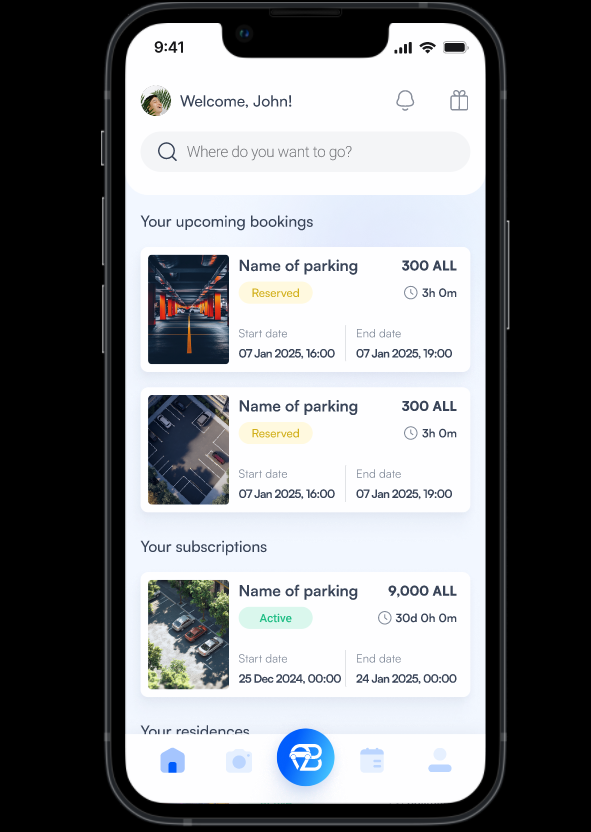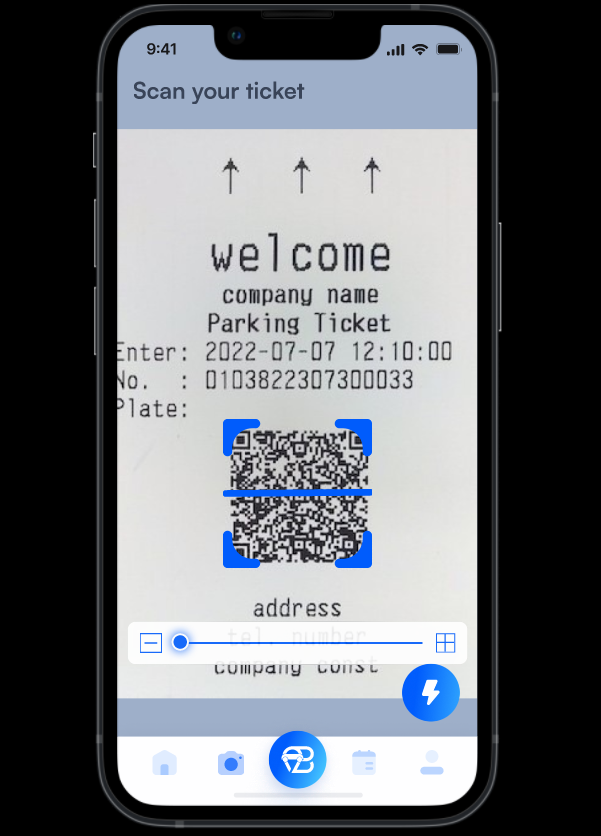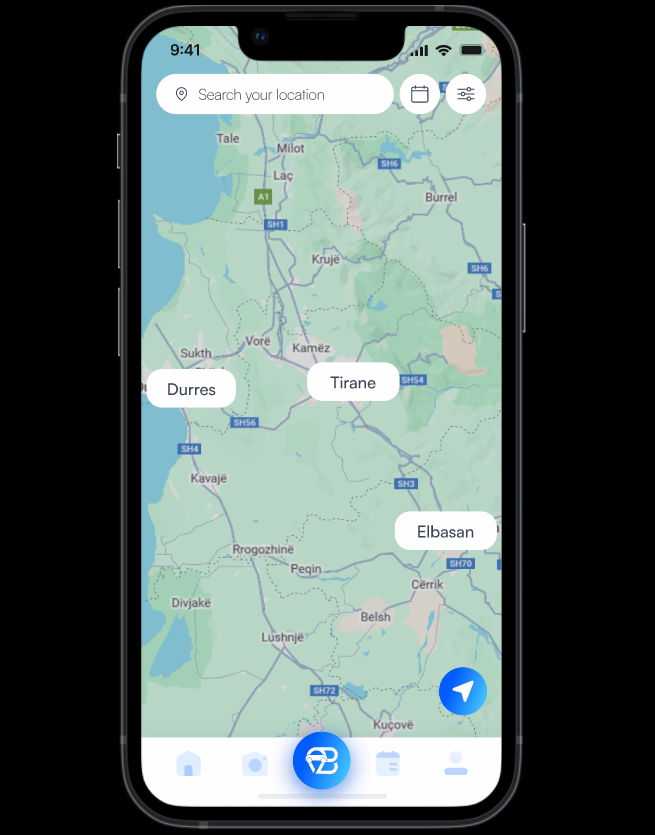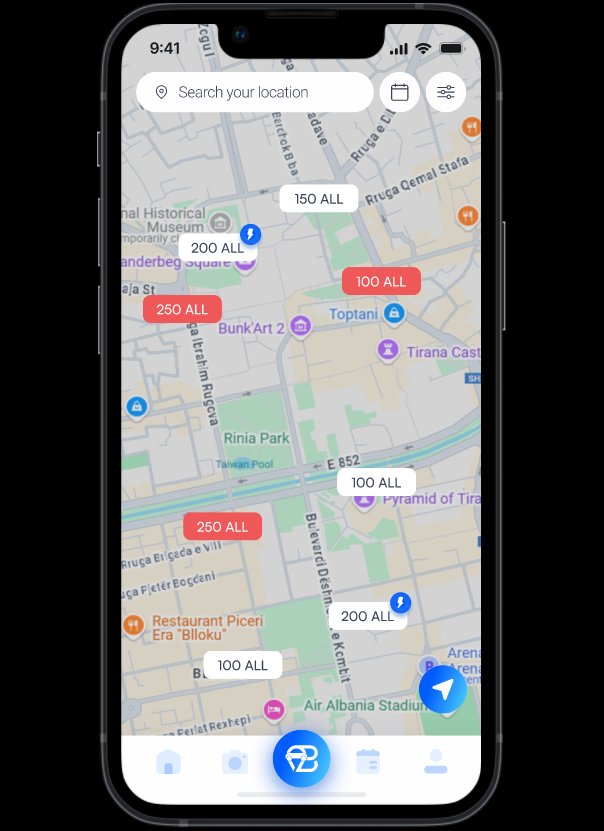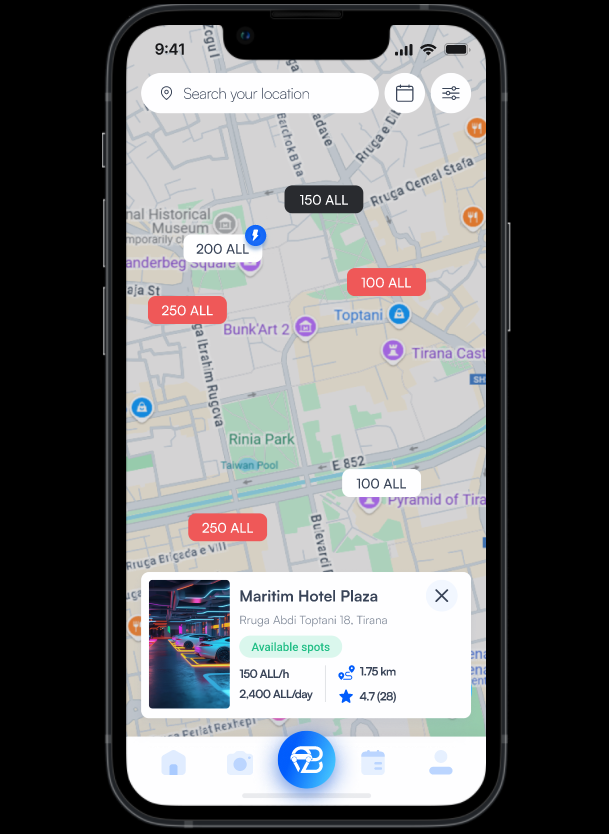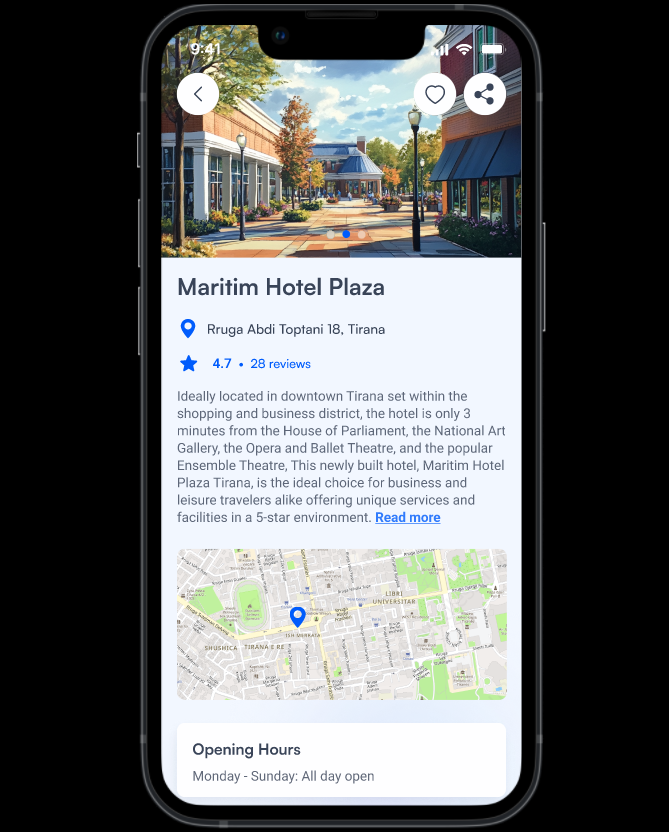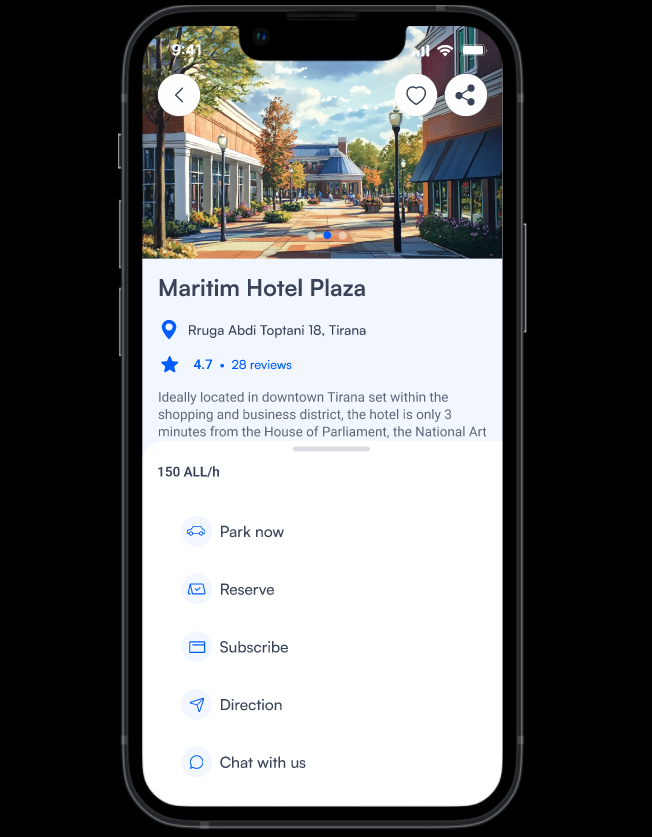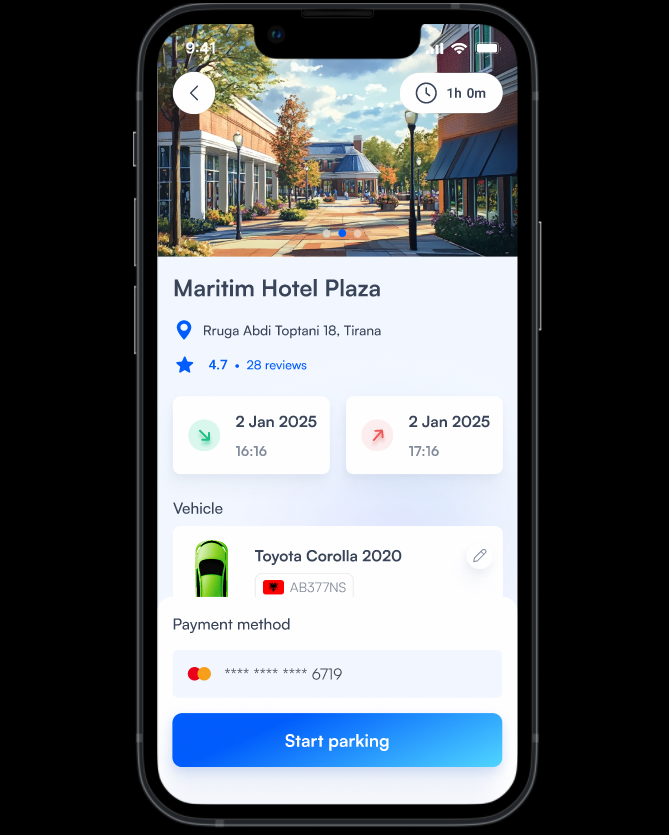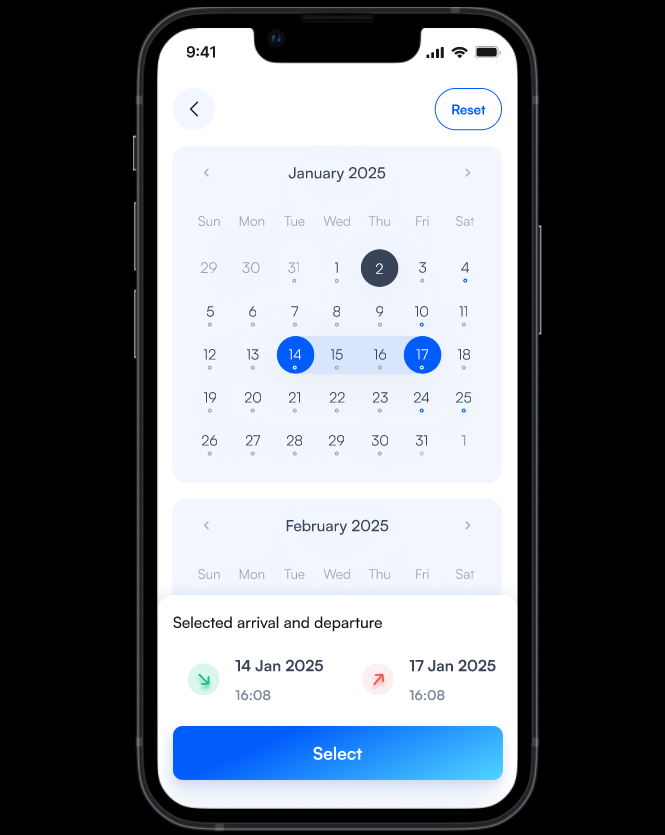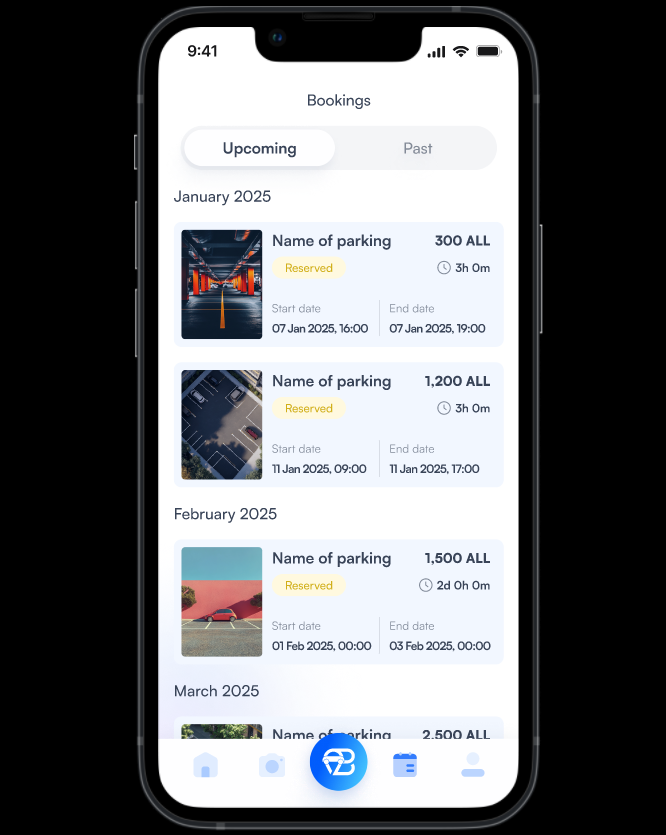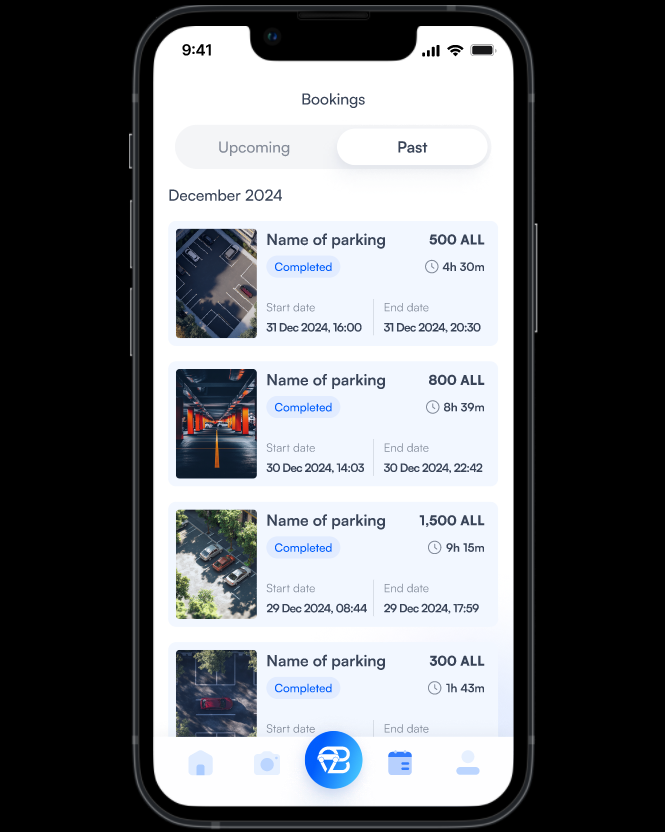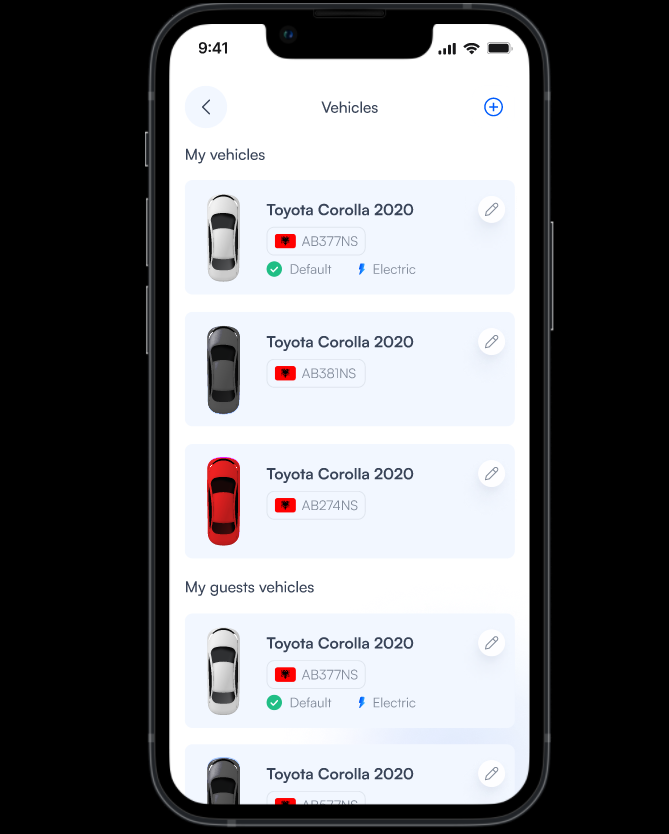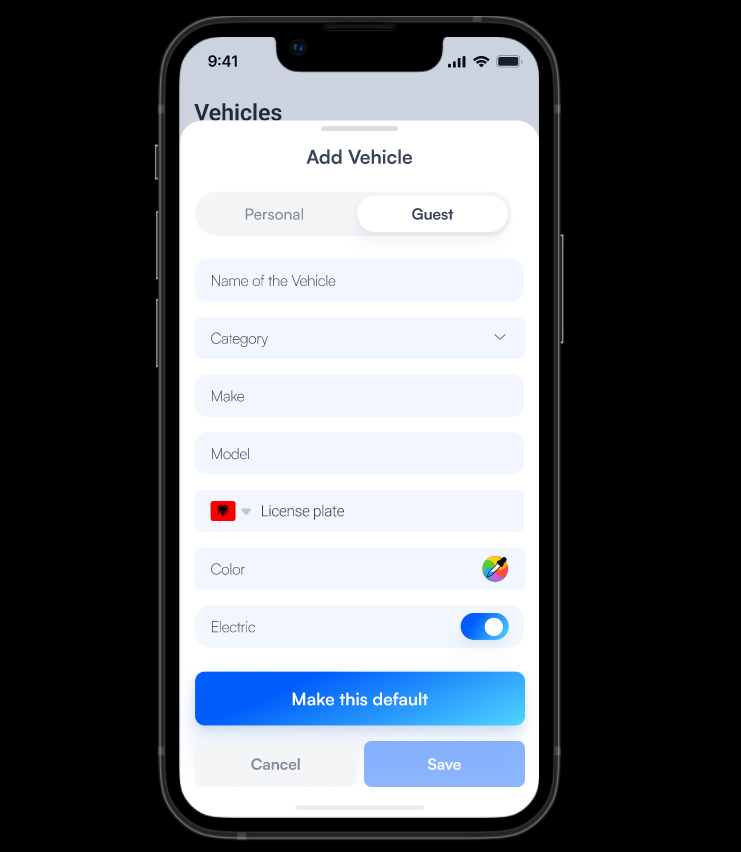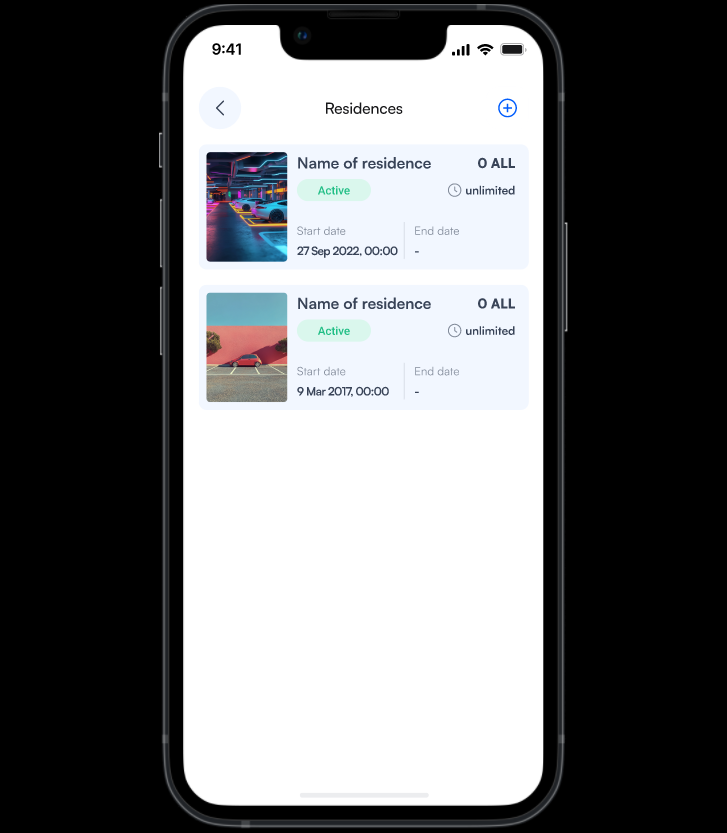Shaping a circular industrial ecosystem and supporting life-cycle thinking
BlueSpot
{Empty}
BlueSpot offers an innovative solution for managing and reserving parking spaces, saving time, reducing stress, and optimizing costs for both individual users and businesses alike.
Albania
Regional
Western Europe, Northern Europe, Southern Europe, Eastern Europe and British Isles
Mainly urban
It refers to other types of transformations (soft investment)
Prototype level
No
No
As a representative of an organisation
BlueSpot is an innovative parking management system designed to streamline the process of finding, reserving, and managing parking spaces while promoting sustainability and green efficiency. The overall aim of the project is to reduce urban traffic congestion, minimize pollution, and optimize the use of existing parking infrastructure through a fully integrated software and electronic system. BlueSpot targets a wide range of users, including individual drivers, parking facility managers, residential complexes, companies, and public institutions.
The project’s specific objectives include enabling real-time access to available parking spaces, supporting cashless and digital payment solutions, and offering comprehensive management tools for both public and private parking areas. BlueSpot also provides dynamic pricing options based on demand, encouraging efficient use of resources and reducing carbon emissions by cutting the time drivers spend searching for parking.
The achieved outcomes so far include the completion of the system’s software architecture, development of a functional demo application compatible with iOS and Android, and collaborations with private parking operators and residential complexes for real-life testing. By facilitating smarter urban mobility and reducing unnecessary fuel consumption, BlueSpot contributes significantly to creating a circular industrial ecosystem and supporting life-cycle thinking in urban environments.
The project’s specific objectives include enabling real-time access to available parking spaces, supporting cashless and digital payment solutions, and offering comprehensive management tools for both public and private parking areas. BlueSpot also provides dynamic pricing options based on demand, encouraging efficient use of resources and reducing carbon emissions by cutting the time drivers spend searching for parking.
The achieved outcomes so far include the completion of the system’s software architecture, development of a functional demo application compatible with iOS and Android, and collaborations with private parking operators and residential complexes for real-life testing. By facilitating smarter urban mobility and reducing unnecessary fuel consumption, BlueSpot contributes significantly to creating a circular industrial ecosystem and supporting life-cycle thinking in urban environments.
Sustainability
Green mobility
Circular economy
Urban efficiency
Smart parking
BlueSpot is designed with sustainability at its core by addressing urban mobility challenges that contribute to increased pollution and inefficient energy use. The project reduces carbon emissions by providing real-time information on available parking spaces, cutting down the time drivers spend circling and searching for parking. This leads to lower fuel consumption and decreased air pollution. Furthermore, BlueSpot promotes the use of electric vehicles by highlighting parking spots equipped with EV charging stations, contributing to the broader adoption of cleaner transportation methods. The dynamic pricing feature optimizes the use of available spaces, preventing the need for unnecessary expansions of parking infrastructure, thus reducing the environmental footprint. By integrating digital payments and eliminating paper tickets, the system further minimizes waste. BlueSpot’s approach exemplifies sustainability by combining smart technology with eco-friendly practices that support a circular industrial ecosystem, aligning perfectly with life-cycle thinking principles.
BlueSpot enhances the urban experience through a user-friendly design and an intuitive interface that simplifies the process of finding and managing parking. The application’s clean and modern aesthetic, paired with seamless navigation, ensures that users of all ages and technical backgrounds can easily access its features. The real-time visualization of parking availability, integrated with maps and location-based services, offers an engaging and efficient user experience. Beyond functionality, BlueSpot contributes to the aesthetic quality of urban areas by reducing traffic congestion and the visual clutter caused by parked cars in public spaces. By streamlining parking management, the system allows for more organized, cleaner streets and neighborhoods. BlueSpot can be exemplary in this context by demonstrating how thoughtful design and technology can create more pleasant, efficient, and culturally enriched urban environments that prioritize people’s well-being.
BlueSpot has been developed with a strong focus on inclusivity, ensuring accessibility and affordability for diverse user groups. The application is intuitive and easy to use, making it accessible to individuals regardless of their age, digital literacy, or physical abilities. Multiple payment methods, including online transactions and cash options, ensure that the platform remains affordable and convenient for all socioeconomic groups. For residential complexes, BlueSpot offers residents control over their parking needs, allowing them to add guests or modify access without the need for administrative intervention. The system also supports inclusive urban planning by facilitating parking solutions for institutions such as universities, hospitals, and public offices, ensuring that staff, visitors, and service providers can access these facilities easily. BlueSpot exemplifies inclusion by bridging technological accessibility gaps and promoting equitable urban mobility, ultimately fostering a more connected and cohesive urban community.
BlueSpot’s development process has been deeply influenced by continuous engagement with citizens and civil society. The project began with extensive consultations involving drivers, parking managers, residents of residential complexes, and representatives from public institutions. Their feedback was crucial in identifying key pain points such as lack of real-time parking information, inefficient payment processes, and traffic congestion. Drivers expressed the need for time-saving and stress-reducing solutions, while parking managers highlighted operational inefficiencies and high costs. Residents emphasized the importance of security and personalized access control within residential areas.
The involvement of civil society not only shaped the design of BlueSpot’s user-friendly interface but also influenced the integration of sustainable features, such as EV charging spot indicators and paperless payment solutions. This collaborative approach ensured that BlueSpot addresses real needs, thereby increasing adoption potential. The impact of this engagement is evident in the system’s intuitive design, accessibility, and focus on reducing environmental impact, all of which reflect the desires and expectations of its future users.
The involvement of civil society not only shaped the design of BlueSpot’s user-friendly interface but also influenced the integration of sustainable features, such as EV charging spot indicators and paperless payment solutions. This collaborative approach ensured that BlueSpot addresses real needs, thereby increasing adoption potential. The impact of this engagement is evident in the system’s intuitive design, accessibility, and focus on reducing environmental impact, all of which reflect the desires and expectations of its future users.
BlueSpot has engaged a diverse range of stakeholders at local, regional, national, and European levels, ensuring a holistic and inclusive approach to its design and implementation. At the local level, partnerships were established with parking operators, residential complexes, and municipal bodies, which provided insights into daily operational challenges and regulatory requirements. Their involvement was key in tailoring the software for flexible access management and dynamic pricing.
At the regional and national levels, collaborations with banks and online payment service providers were initiated to ensure secure, affordable, and efficient transaction processes. Additionally, dialogues with governmental bodies responsible for urban mobility helped align BlueSpot’s functionalities with national sustainability strategies.
At the European level, the project drew inspiration from best practices in urban mobility and sustainability across Western, Northern, Eastern, and Southern Europe, including the British Isles. By analyzing successful implementations and adapting them to local contexts, BlueSpot ensures its relevance across diverse European markets. The added value of this multi-level stakeholder engagement lies in its contribution to creating a scalable, adaptable solution that aligns with broader European sustainability goals.
At the regional and national levels, collaborations with banks and online payment service providers were initiated to ensure secure, affordable, and efficient transaction processes. Additionally, dialogues with governmental bodies responsible for urban mobility helped align BlueSpot’s functionalities with national sustainability strategies.
At the European level, the project drew inspiration from best practices in urban mobility and sustainability across Western, Northern, Eastern, and Southern Europe, including the British Isles. By analyzing successful implementations and adapting them to local contexts, BlueSpot ensures its relevance across diverse European markets. The added value of this multi-level stakeholder engagement lies in its contribution to creating a scalable, adaptable solution that aligns with broader European sustainability goals.
BlueSpot embodies a multidisciplinary approach, combining expertise from various fields, including software engineering, electronic systems development, urban planning, environmental science, finance, and user experience design. The technical team, composed of software engineers and electronic system specialists, worked closely with urban mobility experts to design a system that integrates seamlessly with existing infrastructure while promoting sustainable transport practices.
Environmental scientists provided insights into reducing the carbon footprint of urban traffic, influencing the inclusion of features like real-time parking availability and EV charging station locators. Financial experts facilitated collaborations with banking institutions to develop secure and user-friendly payment systems, while user experience designers ensured that the interface remained intuitive and accessible for all user groups.
The interaction between these disciplines was facilitated through regular collaborative workshops, design sprints, and prototype testing sessions. This interdisciplinary cooperation enabled the creation of a robust, adaptable solution that not only meets technical and functional requirements but also addresses environmental sustainability, user inclusivity, and economic viability. The added value of this process lies in the creation of a comprehensive solution that is greater than the sum of its parts, reflecting the New European Bauhaus principles of sustainability, aesthetics, and inclusion.
Environmental scientists provided insights into reducing the carbon footprint of urban traffic, influencing the inclusion of features like real-time parking availability and EV charging station locators. Financial experts facilitated collaborations with banking institutions to develop secure and user-friendly payment systems, while user experience designers ensured that the interface remained intuitive and accessible for all user groups.
The interaction between these disciplines was facilitated through regular collaborative workshops, design sprints, and prototype testing sessions. This interdisciplinary cooperation enabled the creation of a robust, adaptable solution that not only meets technical and functional requirements but also addresses environmental sustainability, user inclusivity, and economic viability. The added value of this process lies in the creation of a comprehensive solution that is greater than the sum of its parts, reflecting the New European Bauhaus principles of sustainability, aesthetics, and inclusion.
BlueSpot stands out from mainstream parking management solutions by offering a comprehensive, all-in-one system that integrates software and electronic infrastructure to streamline urban parking while prioritizing sustainability and green efficiency. Unlike traditional parking systems that primarily focus on manual processes, limited payment options, and basic management tools, BlueSpot provides real-time information on available spaces, dynamic pricing based on demand, and full digital payment solutions, including QR code scanning for ticketless transactions.
A key innovation is its ability to connect and manage diverse parking environments, including public and private facilities, residential complexes, and institutional spaces, all within a single platform. BlueSpot also uniquely supports electric vehicle adoption by highlighting charging station availability, encouraging sustainable transportation choices. Its focus on circular economy principles is demonstrated through the optimization of existing infrastructure rather than promoting new construction, thus reducing environmental impact. The system’s adaptability across various European regions, with customization options for different urban needs, further differentiates it from conventional solutions, making it a scalable and future-proof model for smart urban mobility.
A key innovation is its ability to connect and manage diverse parking environments, including public and private facilities, residential complexes, and institutional spaces, all within a single platform. BlueSpot also uniquely supports electric vehicle adoption by highlighting charging station availability, encouraging sustainable transportation choices. Its focus on circular economy principles is demonstrated through the optimization of existing infrastructure rather than promoting new construction, thus reducing environmental impact. The system’s adaptability across various European regions, with customization options for different urban needs, further differentiates it from conventional solutions, making it a scalable and future-proof model for smart urban mobility.
BlueSpot’s development followed a user-centered and iterative methodology, ensuring that the final solution addresses the real needs of its diverse user base. The project began with extensive stakeholder consultations, involving drivers, parking operators, residential managers, and institutional representatives, to understand their specific challenges and preferences. This feedback shaped the initial design of the system, focusing on usability, accessibility, and sustainability.
An agile development approach was adopted, allowing for continuous refinement through iterative testing and feedback loops. The software and electronic components were developed concurrently, ensuring seamless integration between digital and physical infrastructure. Real-time pilot testing in collaboration with selected parking facilities and residential complexes enabled the identification and resolution of technical and operational issues before full-scale deployment.
Moreover, BlueSpot applied a life-cycle thinking approach by incorporating dynamic pricing mechanisms and real-time data analysis to optimize resource use and reduce environmental impact. The integration of secure online payment systems, including partnerships with banks and payment providers, ensured both user convenience and financial transparency.
This holistic methodology, combining technical innovation, stakeholder engagement, and sustainable design principles, positions BlueSpot as a pioneering solution in urban parking management, fully aligned with the New European Bauhaus values.
An agile development approach was adopted, allowing for continuous refinement through iterative testing and feedback loops. The software and electronic components were developed concurrently, ensuring seamless integration between digital and physical infrastructure. Real-time pilot testing in collaboration with selected parking facilities and residential complexes enabled the identification and resolution of technical and operational issues before full-scale deployment.
Moreover, BlueSpot applied a life-cycle thinking approach by incorporating dynamic pricing mechanisms and real-time data analysis to optimize resource use and reduce environmental impact. The integration of secure online payment systems, including partnerships with banks and payment providers, ensured both user convenience and financial transparency.
This holistic methodology, combining technical innovation, stakeholder engagement, and sustainable design principles, positions BlueSpot as a pioneering solution in urban parking management, fully aligned with the New European Bauhaus values.
BlueSpot has been designed with scalability and adaptability in mind, making its core elements highly transferable and replicable across different contexts, geographic regions, and user groups. The modular software architecture allows for easy customization based on local regulations, user preferences, and infrastructure requirements, ensuring compatibility with various urban and suburban environments. Its technology-agnostic electronic system can integrate with a wide range of existing hardware, such as parking barriers, EV chargers, payment terminals, and license plate recognition cameras, making it adaptable to diverse operational setups.
The methodology applied—centered around user feedback, agile development, and iterative testing—can be replicated in new locations to ensure local needs are effectively addressed. BlueSpot’s dynamic pricing models and real-time data analytics can be adapted to specific market demands, optimizing parking utilization in cities with different levels of traffic density and infrastructure availability. Additionally, the integration of secure online payment systems, adaptable for different currencies and financial regulations, further supports its transferability.
From residential complexes in metropolitan areas to institutional parking spaces in smaller cities, the lessons learned during BlueSpot’s initial development, such as stakeholder engagement strategies and sustainability-focused design, can guide successful implementations in other European regions and beyond. The system’s capacity to scale without significant infrastructure overhauls makes it an attractive solution for cities seeking to modernize urban mobility with minimal environmental impact.
The methodology applied—centered around user feedback, agile development, and iterative testing—can be replicated in new locations to ensure local needs are effectively addressed. BlueSpot’s dynamic pricing models and real-time data analytics can be adapted to specific market demands, optimizing parking utilization in cities with different levels of traffic density and infrastructure availability. Additionally, the integration of secure online payment systems, adaptable for different currencies and financial regulations, further supports its transferability.
From residential complexes in metropolitan areas to institutional parking spaces in smaller cities, the lessons learned during BlueSpot’s initial development, such as stakeholder engagement strategies and sustainability-focused design, can guide successful implementations in other European regions and beyond. The system’s capacity to scale without significant infrastructure overhauls makes it an attractive solution for cities seeking to modernize urban mobility with minimal environmental impact.
BlueSpot addresses several pressing global challenges through practical, locally implementable solutions. One of the primary challenges it tackles is urban traffic congestion, a significant contributor to carbon emissions and air pollution in cities worldwide. By providing real-time data on available parking spaces and optimizing traffic flow, BlueSpot reduces the time drivers spend searching for parking, thereby lowering fuel consumption and emissions.
The project also contributes to combating climate change by promoting electric vehicle usage, with its integration of EV charging station information and support for dynamic pricing that encourages off-peak usage. This not only reduces greenhouse gas emissions but also optimizes energy consumption, aligning with sustainable urban development goals.
Another global issue addressed by BlueSpot is inefficient land use in urban environments. By optimizing existing parking spaces rather than encouraging the construction of new infrastructure, BlueSpot supports circular economy principles, ensuring that available resources are used more effectively and sustainably.
Additionally, BlueSpot enhances digital inclusion by providing an intuitive, accessible application that accommodates diverse user groups, promoting equitable access to urban mobility services. The project’s scalable design, adaptable to different legal, cultural, and infrastructural contexts across European regions, allows it to serve as a model for addressing global urban mobility challenges through locally tailored solutions.
The project also contributes to combating climate change by promoting electric vehicle usage, with its integration of EV charging station information and support for dynamic pricing that encourages off-peak usage. This not only reduces greenhouse gas emissions but also optimizes energy consumption, aligning with sustainable urban development goals.
Another global issue addressed by BlueSpot is inefficient land use in urban environments. By optimizing existing parking spaces rather than encouraging the construction of new infrastructure, BlueSpot supports circular economy principles, ensuring that available resources are used more effectively and sustainably.
Additionally, BlueSpot enhances digital inclusion by providing an intuitive, accessible application that accommodates diverse user groups, promoting equitable access to urban mobility services. The project’s scalable design, adaptable to different legal, cultural, and infrastructural contexts across European regions, allows it to serve as a model for addressing global urban mobility challenges through locally tailored solutions.
In the year following the application, BlueSpot will focus on finalizing development, testing, and expanding its reach through strategic promotion and implementation. The plan will unfold in three phases:
1) Final development and system integration (months 1-4):
The initial months will complete software and electronic system development, integrating user feedback from preliminary tests. Electronic components like automated barriers, EV charging integrations, and payment kiosks will be synchronized with the software. Security testing will ensure data protection and regulatory compliance.
2) Pilot testing and feedback optimization (months 5-8):
BlueSpot will undergo pilot testing in selected private parking areas, residential complexes, and institutions across diverse European regions. Real-time performance and user experience will be evaluated. Feedback will guide optimizations, with technical adjustments ensuring a seamless user experience and operational efficiency.
3) Full implementation and strategic marketing (months 9-12):
After pilot testing, BlueSpot will launch in partner locations. The marketing campaign will include:
-Digital campaigns on social media and mobility forums.
-On-site promotions and strategic partnerships for bulk adoption.
-Educational workshops to introduce system benefits.
Expansion and continuous improvement:
Post-launch, BlueSpot will expand across Europe, adapting to local regulations and preferences. Continuous monitoring of traffic reduction, emissions impact, and user engagement will guide updates. Partnerships with local governments and green mobility organizations will sustain long-term impact, aligning with New European Bauhaus objectives.
1) Final development and system integration (months 1-4):
The initial months will complete software and electronic system development, integrating user feedback from preliminary tests. Electronic components like automated barriers, EV charging integrations, and payment kiosks will be synchronized with the software. Security testing will ensure data protection and regulatory compliance.
2) Pilot testing and feedback optimization (months 5-8):
BlueSpot will undergo pilot testing in selected private parking areas, residential complexes, and institutions across diverse European regions. Real-time performance and user experience will be evaluated. Feedback will guide optimizations, with technical adjustments ensuring a seamless user experience and operational efficiency.
3) Full implementation and strategic marketing (months 9-12):
After pilot testing, BlueSpot will launch in partner locations. The marketing campaign will include:
-Digital campaigns on social media and mobility forums.
-On-site promotions and strategic partnerships for bulk adoption.
-Educational workshops to introduce system benefits.
Expansion and continuous improvement:
Post-launch, BlueSpot will expand across Europe, adapting to local regulations and preferences. Continuous monitoring of traffic reduction, emissions impact, and user engagement will guide updates. Partnerships with local governments and green mobility organizations will sustain long-term impact, aligning with New European Bauhaus objectives.



